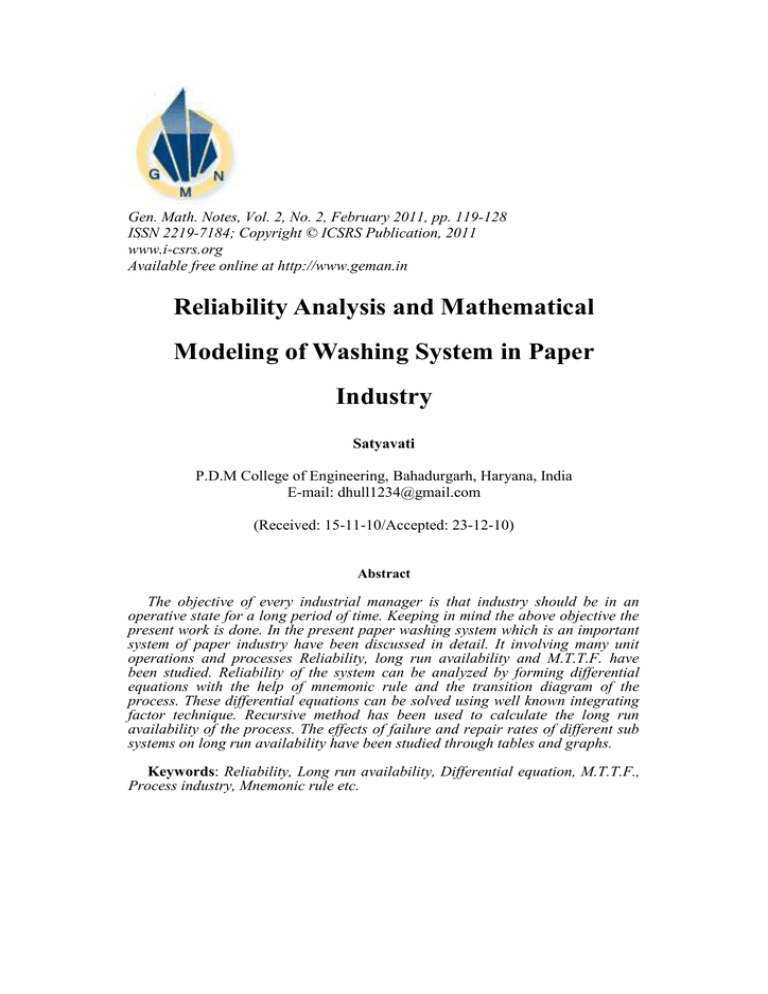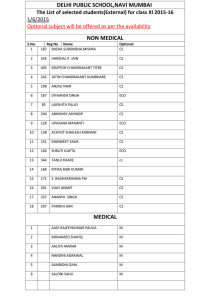Gen. Math. Notes, Vol. 2, No. 2, February 2011, pp.... ISSN 2219-7184; Copyright © ICSRS Publication, 2011
advertisement

Gen. Math. Notes, Vol. 2, No. 2, February 2011, pp. 119-128
ISSN 2219-7184; Copyright © ICSRS Publication, 2011
www.i-csrs.org
Available free online at http://www.geman.in
Reliability Analysis and Mathematical
Modeling of Washing System in Paper
Industry
Satyavati
P.D.M College of Engineering, Bahadurgarh, Haryana, India
E-mail: dhull1234@gmail.com
(Received: 15-11-10/Accepted: 23-12-10)
Abstract
The objective of every industrial manager is that industry should be in an
operative state for a long period of time. Keeping in mind the above objective the
present work is done. In the present paper washing system which is an important
system of paper industry have been discussed in detail. It involving many unit
operations and processes Reliability, long run availability and M.T.T.F. have
been studied. Reliability of the system can be analyzed by forming differential
equations with the help of mnemonic rule and the transition diagram of the
process. These differential equations can be solved using well known integrating
factor technique. Recursive method has been used to calculate the long run
availability of the process. The effects of failure and repair rates of different sub
systems on long run availability have been studied through tables and graphs.
Keywords: Reliability, Long run availability, Differential equation, M.T.T.F.,
Process industry, Mnemonic rule etc.
120
1
Satyavati
Introduction
Reliability Analysis can benefit the industry in terms of higher productivity and
lower maintenance cost. This can also help the management to understand the
effect of increasing/decreasing the repair rate of a particular component or
subsystem on the overall system. These issues along with mathematical model are
discussed in this study regarding washing subsystem, a subunit of paper industry.
Several researchers for the last many years have discussed the various facts of
reliability technology of the subsystems or systems in process industries at various
level and a number of research papers have been published in this direction
including Singh.J.(1982,84) Kumar.D.(1989,91) Mahajan.P. and Singh.J. (1996),
Singh and Gupta (2004), Gupta Pawan and Jai Singh(2005), Singh T.P. and
Satyavati (2007) and some other researchers applied reliability technology to
various industrial systems obtaining important results.
Paper making process is a very complex process industry involving many unit
operations and processes. It is a process industry in which we cannot bypass
intermediate sub process. It consists of six subsystems: feeding, pulp preparation,
washing, bleaching, screening and paper production. Washing system is an
important sub system of paper industry. It consist of many units. During operation
the complex subsystem may fail partially or completely due to fault in any unit.
The failed unit are repaired or replaced as soon as possible to keep the system
available for good output. We discuss in detail the availability of system under
some assumptions, taking constant failure and repair times for various equipments
of the system. The differential equations associated with the system are solved
recursively. Expressions for various parameters of the system as reliability
function, availability function followed by some special cases are discussed. The
effects of failure and repair rates on Long run availability of different subsystems
are studied by tables.
2
Washing System Description
It consists of the following subsystems:The screen (A) having two units in series. It is used to remove oversize uncooked
and odd shape fibers from the pulp through straining. Failure of one unit causes
complete failure of the subsystem.
The cleaner (B) having m units in parallel. The failure of any one unit reduces the
efficiency of the subsystem which downs the quality of the paper and hence
reduces the profit. The failed unit can be repaired by unskilled workers.
The Decker (D) having one main unit and a standby. Failure of both units causes
complete failure of the subsystem.
The system description is shown in Block diagram 1.
Reliability Analysis and Mathematical…
121
Screen (A)
Pulp from tank
2
1
Undesirable
Material
Collector
Cleaner (B)
1
Decker (Washer)
2
m
1
2
(Water+Liquid Collector)
Washed Pulp
Tank
(Block Diagram 1)
3
Assumptions
(a)
(f)
The repaired/ replaced units are as good as new performance wise. Units
are repaired or replaced upon failure only.
Each subsystem is provided separate repair facility.
Mean failure and repair rates of the units are constant over time unless
otherwise stated about any change for equal time interval and are
statistically independent.
The probability of more than one subsystem failure / repair during the
interval (t , t+ ∆ t) is zero. (e) The standby units (if any) are of same nature.
The subsystem B failed through reduced state.
4
Notations
(b)
(c)
(d)
a,b,d1
B
D1
αi
:
:
:
:
denote the failed state of the system.
denote the reduced states of the system.
denote the failure of one unit of D.
denotes the respective failure rate of the unit.
122
Satyavati
βi
:
denotes the respective repair rate of the unit.
pi(t) :
State probability at time t
Taking the above assumptions and notations, we obtain the transition diagram
shown in fig.2
AbD
α2
AB D
α1
α3
α3
ABD
1
β2
α1
ABD1
3
aBD1
β1
9
α2
α3
aB D
9
β2
β3
5
β3
β3
β1
8
Abd1
α 1 β1
β2
α2
2
7
aBD
6
4
12
AbD1
β2
α3
α2
α1
Good State
AB d1
AB D1
10
β3
β1
Reduced State
aB D1
Failed State
11
State Transition Diagram – 2
5
Mathematical Formulation
Probability considerations give the following differential difference equations.
3
d
+
dt ∑ α i p1 (t ) = β 1 p 7 (t ) + β 2 p 2 (t ) + β 3 p 3 (t ) ........................ (1)
1
3
d
dt + Σ α i + β 2 p 2 (t ) = α 2 p1 (t ) + β 1 p 5 (t ) + β 2 p 6 (t ) + β 3 p 4 (t ) ...... (2)
1
d 3
+ Σ α i + β 3 p3 (t ) = α 3 p1 (t ) + β1 p9 (t ) + β 2 p4 (t ) + β 3 p8 (t ) ............ (3)
dt 1
Reliability Analysis and Mathematical…
123
3
d 3
+
β
+
dt Σ i Σαi p4 (t ) =α2 p3 (t ) +α3 p2 (t ) + β3 p10 (t ) + β1 p11(t ) + β2 p12 (t )
2
1
……...(4)
d
dt + β 1 p 5 (t ) = α 1 p 2 (t ) ...................... (5)
d
dt + β 2 p 6 (t ) = α 2 p 2 (t ) .................... (6)
d
dt + β 1 p 7 (t ) = α 1 p1 (t ) ...................... (7)
d
dt + β 3 p 8 (t ) = α 3 p 3 (t ) ...................... (8)
d
dt + β 1 p 9 (t ) = α 1 p 3 (t ) ...................... (9)
d
dt + β 3 p10 (t ) = α 3 p 4 (t ) ..................... (10)
d
dt + β 1 p11 (t ) = α 1 p 4 (t ) ......................... (11)
d
dt + β 2 p12 (t ) = α 2 p 4 (t ) ...................... (12)
Initial condition {pi(o) = 1 if i = 1
= 0 , otherwise}.
Solution of the equations (1) to (12)
Σαi
Σ α i −Σ α i
p1 (t ) = e 1 ∫ {β1 p7 (t ) + β 2 p2 (t ) + β 3 p3 (t )}e 1 dt + e 1
−
3
3
3
[
p2 (t ) = e −λ1 ,t ∫{α 2 p1 (t ) + β1 p5 (t ) + β 2 p6 (t ) + β 3 p4 (t ) }e
p3 (t ) = e
p4 (t ) = e
[∫{α p (t ) + β p (t )+ β p (t ) + β p (t )}e
[∫{α p (t ) + α p (t )+ β p (t )+ β p (t )+ β
[∫ {α p (t )}e dt ]
[∫{α p (t )}e dt ]
[∫ α p (t ) e dt ]
[∫ α p (t ) e dt ]
[∫ α p (t ) e dt ]
[∫ α p (t ) e dt ]
[∫ α p (t ) e dt ]
−λ2 t
− λ3t
p5 (t ) = e − β1t
p 6 (t ) = e − β 2 t
p 7 (t ) = e − β1t
p 8 (t ) = e − β 3t
p 9 (t ) = e − β1 t
p10 (t ) = e − β 3 t
p11 (t ) = e − β1 t
λ2 t
3
1
2
3
1
2
1
9
3
2
β1 t
β 2t
2
2
β1 t
1
1
β 3t
3
3
β1 t
1
3
β3 t
3
4
β1 t
1
4
2
3
4
10
3
1
8
11
2
λ1 t
dt
dt
]
]
p12 (t )}e λ3 t dt
]
124
Satyavati
[
p12 (t ) = e − β 2 t ∫ α 2 p4 (t ) e β 2 t dt
3
Where
λ1 = Σ α i + β 2
1
]
3
λ2 = Σ α i + β 3
1
3
3
2
1
λ3 = Σ β i + Σ α i
All the probabilities are in terms of p1(t) which is terms given by (1)
The reliability of the subsystem is given by
R(t) = P1(t) + P2(t) +P3(t) + P4(t)
6
Long Run Availability
Since the management is interested in long run availability of the system, we find
d
the probabilities as follows, taking
→ o as t → ∞, pi (t ) → pi
dt
3
Σα
i
p1 = β1 p 7 + β 2 p 2 + β 3 p 3 .................... (13)
1
3
Σ α i + β 2 p 2 = α 2 p1 + β 1 p 5 + β 2 p 6 + β 3 p 4 .................... (14)
1
3
Σ α 1 + β 3 p 3 = α 3 p1 + β 1 p 9 + β 2 p 4 + β 3 p8 .................... (15)
1
3
3
Σ β i + Σ α i p4 = α 2 p3 + α 3 p2 + β 3 p10 + β1 p11 + β 2 p12 .................... (16)
1
2
β 1 p 5 = α 1 p 2 .................... (17)
β 2 p 6 = α 2 p 2 .................. (18)
β 1 p 7 = α 1 p1 .................... (19)
β 1 p 9 = α 1 p 3 .................... (21)
β 1 p11 = α 1 p 4 .................. (23)
β 3 p 8 = α 3 p 3 .................... (20)
β 3 p10 = α 3 p 4 .................. (22)
β 2 p12 = α 2 p 4 .................. (24)
Initial condition p1= 1, otherwise zero.
These equations are solved recursively in terms of p1. Now p1 is evaluated using
12
normalizing condition
Σ
i =1
pi = 1
The long run availability of the system is obtained as follows :
A3 = P1+ P2+P3+P4
7
Non – Repairable Case
If system is non repairable, then putting β j = 0, for all j, we have
Reliability Analysis and Mathematical…
125
d 3
dt + Σα i p1 ( t ) = 0 ....................(25)
1
3
d
dt + Σα i p2 ( t ) = α 2 p1 ( t ) ....................(26)
1
3
d
dt + Σ α i p 3 (t ) = α 3 p1 (t ) .................... (27)
1
3
d
dt + Σ α i p 4 (t ) = α 2 p 3 (t ) + α 3 p 2 (t ) .................... (28)
1
d
p5 (t ) = α1 p2 (t ) .................... (29)
dt
d
p6 (t )= α 2 p2 (t ) .................... (30)
dt
d
p7 (t ) = α1 p1 (t ) .................... (31)
dt
d
p8 (t ) = α 3 p3 (t ) .................... (32)
dt
d
p9 (t ) = α1 p3 (t ) .................... (33)
dt
d
p10 (t ) = α 3 p4 (t ) .................... (34)
dt
d
p11 (t ) = α1 p4 (t ) .................... (35)
dt
d
p12 (t ) = α 2 p4 (t ) .................... (36)
dt
Initial condition is p1(0) =1, otherwise zero.
All the above probabilities are in terms of p1(t) which is given by solving equation
(25)
3
p1 (t ) = exp − Σ α i t
1
8
Analysis of System
Using equation (13) to (24)
α
P1 = 1 + 2
β 2
P2 =
α2
P1
β2
α 3 α1 α 2
1 + 1 + +
β 3 β1 β 2
P3 =
α3
P1
β3
2
α3 α3
1 +
+
β3 β3
P4 =
2
α2
1 +
β2
α 2α 3
P1
β 2 β3
−1
126
Satyavati
αα
P5 = 1 2 P1
β1 β 2
α
P6 = 2
β2
2
P1
P7 =
α α
P9 = 1 3 P1
β1 β 3
2
α
P8 = 3 P1
β3
αα α
P11 = 1 2 3 P1
β1 β 2 β 3
α1
P1
β1
2
α α2
P10 = 3
P1
β3 β2
2
α α3
P12 = 2
P1
β2 β3
α α
A = P1 + P2 + P3 + P4 = 1 + 2 1 + 3 P1
β2 β3
(a)
Effect of failure rate (α1 ) of screen and (α 2 ) of cleaner on long Run
Availability
Taking α 3 = .02 β1 = .03 β 2 = .04 β 3 = .05
α1 →
Table1
.01
.02
.03
.04
.05
.001
.690500
.561307
.472837
.408458
.359510
.002
.689671
.560748
.472441
.408164
.359290
.003
.688317
.559873
.471805
.407694
.358922
.004
.686494
.558647
.4709480
.407049
.358418
.005
.684226
.557173
.469886
.406261
.357802
α2 ↓
(b)
Effect of repair rate (β1 ) of screen and (β 2 ) of cleaner on long run availability.
Taking α1 = .01, α 2 = .001, α 3 = .02, β 3 = .05
β1 →
Table 2
.01
.02
.03
.04
.05
.470948
.616
.686478
.728132
.755643
β2 ↓
.01
Reliability Analysis and Mathematical…
127
.02
.472441
.618557
.689655
.731707
.759494
.03
.472733
.619057
.690279
.732409
.760268
.04
.472837
.619235
.690499
.732657
.760517
.05
.472885
.619319
.690602
.732774
.760643
9
Concluding Remarks
1
The study of Table 1 shows that the failure rate α 1 of screen affects the
2
availability more than failure rate α 2 of cleaner.
Study of Table II shows that the repair rate β1 of screen affects the
availability more than repair rate β 2 of cleaner.
Thus we can make an inference that Management should take more care about
failure rate, repair rate of screen in order to improve availability of the system.
References
[1]
[2]
[3]
[4]
[5]
[6]
[7]
[8]
[9]
[10]
J. Singh, Reliability of a fertilizer production supply problem, Pro. Of
ISPTA, Wiley Eastern (1984).
D. Kumar, I.P. Singh and J. Singh, Reliability analysis of the feeding
system in paper industry, Micro and Relib, 28(2) (1988).
D. Kumar and J Singh., Availability of washing system in paper industry,
Micro and Reliab, 29 (5) (1989).
D. Kumar, Analysis and optimization of system availability in suger, paper
and fertilizer industries, Ph.D. thesis, Roorkee University, India (1991).
P. Mahajan and J. Singh, Reliability analysis of a straw board mill,
Proceedings of National Conference on O.R. in Moderen Technology,
(1996).
P. Gupta, Reliability and availability analysis of some process industries,
Ph.D. thesis, TIET Patiala, India, (2003).
P. Gupta, A.K. Lal, R.K. Sharma, J. Singh, Numerical analysis of
reliability and availability of the serial processes in butter-oil processing
plant, International Journal of Quality & Reliability Management,
22(Issue 3) 2005, 303 - 316
T.P. Singh and Satyavati, Assessment measures of nuclear power
generation plant under head-of-line repair, Reflection era, 2(2007), 223238.
Satyavati and T.P. Singh, Reliability prediction of pulp system in paper
industry, Int. Journal of Agriculture & Stastical Sciences, 2 (2008).
J Singh, K. Kumar and A. Sharma, Availability evaluation of an
automobile system, Journal of Mathematics and System Sciences, 4(2)
(2008), 95-102.
128
[11]
Satyavati
P.H. Tsarouhas, Classification and calculation of primary failure modes in
bread production line, Reliability Engineering and System Safety,
94(issue2) 2009, 551-557.




